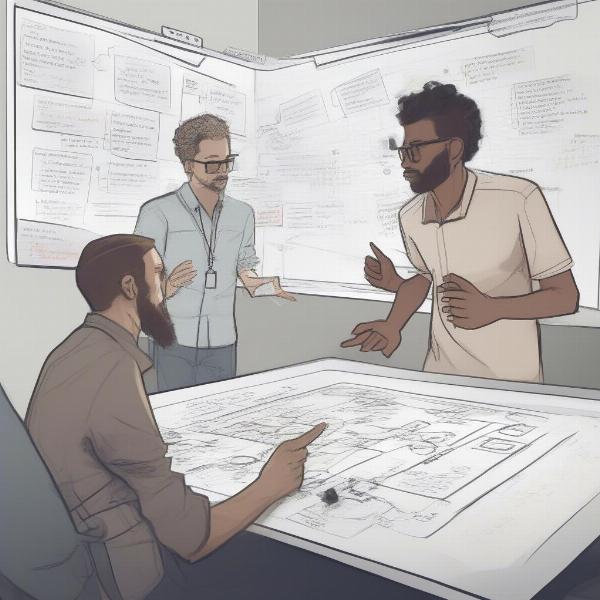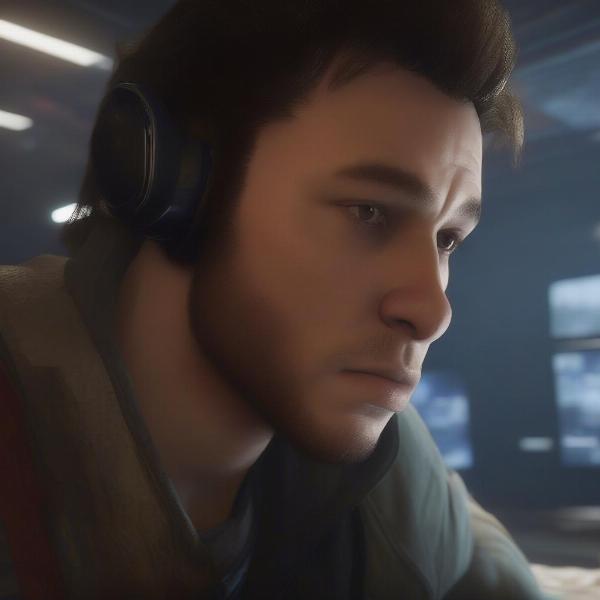While both game designers and writers craft narratives and experiences, their roles diverge significantly. They are distinct yet interconnected, like two sides of the same coin, contributing to the immersive experience we crave in games. Understanding the nuances of each role is crucial for anyone interested in the gaming industry.
Similar to coordinating multiple individuals on a game project, understanding the distinct roles within the team is vital. This article dives deep into the differences between a game designer and a writer, exploring their unique contributions to the gaming world.
Defining the Roles: Designer vs. Writer
A game designer is the architect of the game’s mechanics, systems, and overall gameplay. They focus on how the game plays, designing rules, challenges, progression systems, and the overall player experience. Think of them as the engineers of fun. A writer, on the other hand, crafts the narrative elements of the game, including the story, dialogue, character development, and world-building. They are the storytellers, bringing the game’s world and characters to life.
The Core Differences: Mechanics vs. Narrative
The most fundamental difference lies in their focus: mechanics versus narrative. A game designer’s primary concern is how the player interacts with the game world, while a writer focuses on the story being told within that world. A designer might create a complex combat system, while a writer would develop the backstory of the characters fighting and the motivations behind their conflict.
While their primary responsibilities differ, there is often overlap and collaboration. A writer’s dialogue might inform a designer’s choices about character abilities, and a designer’s level design could influence a writer’s narrative direction. This symbiotic relationship is crucial for creating a cohesive and engaging game experience.
 Game Designer and Writer Collaboration
Game Designer and Writer Collaboration
What Skills Does Each Role Require?
Both roles demand a unique skill set. Game designers require a strong understanding of game mechanics, systems design, level design, balancing gameplay, and user experience (UX). They need to be analytical and problem-solvers, able to anticipate player behavior and create engaging challenges. Writers, on the other hand, need exceptional storytelling abilities, strong writing skills, a knack for character development, and the ability to create immersive worlds. They must be creative and imaginative, capable of drawing players into the narrative.
How Do They Work Together?
Collaboration is key to a successful game. Designers and writers must work closely together to ensure that the mechanics and narrative complement each other, creating a unified and engaging experience. For example, a writer might create a compelling backstory for a character, which then inspires the designer to create unique abilities that reflect that character’s personality and history. This collaborative process ensures that the game’s mechanics and narrative are interwoven, enhancing the overall player experience.
Do Their Roles Ever Overlap?
While their core responsibilities are distinct, there can be some overlap between the roles. A game designer might contribute to the narrative by designing levels that tell a story through environmental storytelling, while a writer might suggest gameplay mechanics that enhance the narrative experience. This blurring of lines can lead to a more cohesive and immersive game world.
What Careers Can Each Role Lead To?
Both roles offer various career paths within the game industry. Game designers can specialize in areas like level design, systems design, or combat design. Writers can pursue roles such as narrative designer, dialogue writer, or world-builder. Both career paths offer exciting opportunities to contribute to the creation of compelling and immersive game experiences.
FAQs About Game Designers and Writers
1. What is the difference between a game designer and a game developer?
A game developer is a broad term encompassing everyone involved in creating a game, including programmers, artists, and designers. A game designer is a specific role within game development, focusing on the gameplay and mechanics.
2. Do game writers need to know how to code?
Generally, no. While some coding knowledge can be helpful, it’s not a mandatory requirement for most game writing positions. Strong writing and storytelling skills are more crucial.
3. Can a game designer also be a writer?
Yes, absolutely! Some individuals possess both the analytical skills required for game design and the creative flair for writing. These multi-talented individuals can bring a unique perspective to game development.
4. What is the typical salary for a game designer/writer?
Salaries vary depending on experience, location, and company size. However, both roles offer competitive salaries within the tech industry.
5. How can I become a game designer/writer?
Building a strong portfolio is crucial. Gain experience through personal projects, game jams, or internships. A strong educational background in game design or creative writing can also be beneficial.
6. What software do game designers/writers use?
Game designers often use specialized software for level design, prototyping, and scripting. Writers typically use word processing software, but may also utilize narrative design tools.
7. What is the future of game design and game writing?
With the continued growth of the gaming industry and the emergence of new technologies like VR and AR, both fields are expected to evolve and offer exciting new opportunities.
Narrative Design and Player Agency
Narrative design plays a significant role in creating compelling game experiences. By carefully crafting the story, characters, and world-building, writers can draw players into the game’s world and invest them in the narrative. This is particularly important in games that emphasize storytelling and character development.
 Narrative Design Enhancing Player Immersion
Narrative Design Enhancing Player Immersion
Conclusion
Understanding the distinction between a game designer and a writer is fundamental for appreciating the complexities of game development. Both roles, though distinct, are integral to creating immersive and engaging game experiences. While a game designer focuses on the “how” of gameplay, a writer focuses on the “why,” crafting narratives that breathe life into the game’s world. Their collaboration is a delicate dance of mechanics and storytelling, resulting in the games we love to play. If you are passionate about games, exploring these roles might lead you to your dream career. Consider furthering your understanding of managing a team within game development, as collaboration is a cornerstone of this industry.

